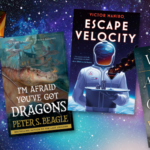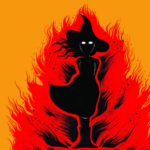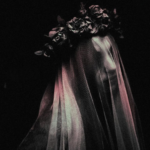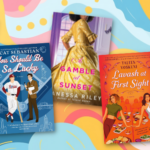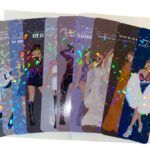
Critical Thinking and Books
I remember the exact moment I realized my brain could be used for critical thinking. It was my freshman year of college, in my English 101 class. The professor assigned The Yellow Wallpaper by Charlotte Perkins Gilman, which we were to have read before the class discussion. I started it but was having a hard time understanding and couldn’t stick with it. At the time, I didn’t know what an unreliable narrator was or that a text could intentionally lie to me for the sake of a good story. On discussion day, the professor was reading excerpts from the text, asking for people’s opinions. I was keeping quiet in my seat, trying to look like I wasn’t completely lost. Then she said, and I’ll never forget it, “This is a place where I disagree with the text,” and continued her lecture.
At this point, I could have been in another dimension; I was so struck by what she said. We were allowed to disagree with the text? I had no idea. Having gone to conservative Christian schools my whole life and growing up in a carefully curated bubble, I was expressly taught never to question anything I was given to read. The authority of the Bible was absolute, as was the word of my teachers and the Abeka textbooks we learned from. In fact, questioning was considered disrespectful. If I was allowed to question, more than that, critique what I read, then what did that mean for my beliefs? What had I read previously that I could have disagreed with?
I was so far behind where my peers were in their thinking skills. That first year of college was a steep learning curve for me. Today, I’m relieved I stuck with it and took the time to teach myself a new way to think. When I became a teacher, it was paramount that I teach my students how to think, not just how to regurgitate information. It’s difficult to teach 13-16-year-old teens how to analyze texts, not least because their brains aren’t fully developed. It’s more so because they haven’t had to think much on their own up to that point, especially this latest generation, who were born with cell phones and iPads in front of their faces at restaurants and grocery store carts to keep them entertained. No information ever denied them, no thinking required.
Since information is literally at our thumb-tips, it’s more imperative than ever to sharpen critical thinking skills. Misinformation looks more realistic than ever. If we are not aware of opportunities for confirmation bias, not aware of bringing our personal context to what we read, and not aware of how strong emotional reactions can color how we receive information, then we are doing ourselves a disservice. First, there are a few important distinctions to make.
Critical Reading vs. Critical Thinking
It may seem like semantics, but there are important differences between critical reading and critical thinking. Critical reading is a set of skills brought to the reading process that helps the reader discover and learn new information. Critical thinking, on the other hand, is a set of skills used to evaluate what has been read and to decide what to believe as a result of understanding and analyzing that new information.
The two work together to help us develop a more complete understanding of an idea or topic. While reading, we may question the information that is being read. This is critical thinking that leads to closer, more critical reading to evaluate whether what we think is true.
Critical reading strategies are skills we remember learning in school. It could be annotating, paraphrasing, outlining, summarizing, identifying figurative language, or evaluating the logic of arguments. The steps for critical reading are straightforward and easily identifiable. Of the two, reading critically is much easier to learn and practice.
So What is Critical Thinking Then?
Critical thinking is the “objective, systematic, and rational analysis and evaluation of factual evidence in order to form a judgment on a subject, issue, etc.” Generally, critical thinking is broken up into several elements: making judgments, being curious about the truth, being inquisitive, having confidence in your reasoning skills, being systematic and analytical, and keeping an open mind. Of course, these can be broken down further into categories like inference and interpretation.
Basically, critical thinking is thinking about your thoughts. Are you a baby bird with its mouth open, ready to gobble up whatever information is fed to you? If so, you’re like teenaged Nikki: happy with the world she lived in, no need to question anything.
Critical Thinking and Books
This applies to books because we need to be cognizant of what information and stories we are feeding our brains. Thinking about what I’ve read and discussing it with others is one of the biggest pleasures of the reading experience for me. It’s important to remember that words printed on a page that has been bound into a book doesn’t make those words true.
John Green says that books belong to their readers. What a relief for this reader. If the book belongs to me, then I can analyze, infer, and bring my life context to anything I read without needing to consider what the author meant. Analysis hot take: if I can’t understand what the writer was trying to do or the message they’re trying to send, then that’s on the author. At the same time, I acknowledge that knowing who the intended audience is can influence the readers’ takeaways. All books aren’t for all people. If I can’t make it through a book or want to throw the book against the wall or am internally rolling my eyes while reading, then that book probably isn’t for me.
But if books do belong to us once they are published or printed or posted, then it’s our responsibility to bring our complete functioning minds to the text. We can decide what we want to take away from it, what we disagree with, what questions the content is provoking in us. Before hopping on Goodreads or Reddit to complain about something you just read, think about what the text was doing. Think about your response.
If a character does something you disagree with or an argument rubs you the wrong way, instead of jumping to conclusions about authors and their beliefs, you should question why you had such a strong reaction to it. Critical thinking needs to be practiced outside the text as well. You can’t assume that because a book has an illustrated cover, it’s appropriate for children. That book might be a romance novel with steamy sex scenes and adult themes.
Sometimes, our strong responses are warranted. Opinions are going to differ from ours, and that might be offensive to us, and that’s okay. We’re allowed to disagree so long as we are curious enough and resourceful enough to make sure our opinions are grounded in fact. The same goes for confirmation bias. We can’t just read one thing we agree with and not find any other supporting evidence. That’s irresponsible reading, baby bird reading.
Our minds are wondrous tools that have the ability to understand, analyze, and interrogate the books that we read. We can separate authors from their books. We can take a pause before acting on emotional reactions to things we read. Whether the book is informative or entertaining, it’s our responsibility to learn from our reading experiences. To take those experiences from one book and apply what we learned from them to the next.



